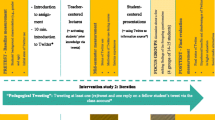Abstract
Researchers have argued that Twitter has potential to support high-quality professional development (PD) that can respond to teachers’ questions and concerns just in time and “on the spot.” Yet, very little attention has been paid to instances where Twitter has made just-in-time learning possible. In this paper, we examine one instance of timely professional development on Twitter, in which 3,598 users used an educational hashtag—#educattentats—to create a temporary affinity space supporting French teachers preparing to discuss recent terrorist attacks with their students. We describe this just-in-time PD by focusing on participants and modes of participation, the spread of the hashtag in its first hours and the growth and eventual decline of the hashtag over the course of 28 days. The results of this study suggest that #educattentats served effectively as just-in-time professional development for teachers. Implications for research and practice are discussed.





Similar content being viewed by others
Change history
15 June 2019
Since this paper���s publication, it has come to our attention that two of the tables included in the paper were calculated using a slightly different dataset than the rest of our analysis.
15 June 2019
Since this paper���s publication, it has come to our attention that two of the tables included in the paper were calculated using a slightly different dataset than the rest of our analysis.
References
Anderson, S. (2012). A brief history of #edchat [Blog post]. Retrieved from http://blog.web20classroom.org/2012/03/brief-history-of-edchat.html.
Carpenter, J. (2015). Preservice teachers’ microblogging: professional development via Twitter. Contemporary Issues in Technology and Teacher Education, 15, 209–234.
Carpenter, J. P., & Krutka, D. G. (2014). How and why educators use Twitter: a survey of the field. Journal of Research on Technology in Education, 46, 414–434. doi:10.1080/15391523.2014.925701.
Carpenter, J. P., & Krutka, D. G. (2015). Engagement through microblogging: educator professional development via Twitter. Professional Development in Education, 41, 707–728. doi:10.1080/19415257.2014.939294.
Darling-Hammond, L., & McLaughlin, M. W. (1995). Policies that support professional development in an era of reform. Phi Delta Kappan, 76, 597–604.
Easton, L. B. (2008). From professional development to professional learning. Phi Delta Kappan, 89, 755–759.
Gao, F., & Li, L. (2016). Examining a one-hour synchronous chat in a microblogging-based professional development community. British Journal of Educational Technology. doi:10.1111/bjet.12384.
Gao, F., Luo, T., & Zhang, K. (2012). Tweeting for learning: a critical analysis of research on microblogging in education published in 2008–2011. British Journal of Educational Technology, 43, 783–801. doi:10.1111/j.1467-8535.2012.01357.x.
Gee, J. P. (2004). Situated language and learning: A critique of traditional schooling. New York: Routledge.
Greeno, J., Collins, A., & Resnick, L. (1996). Cognition and learning. In D. Berliner & R. Calfee (Eds.), Handbook of educational psychology (pp. 15–46). New York: Macmillan.
Hawksey, M. (2014). Need a better Twitter Archiving Google Sheet? TAGS v6.0 is here! [Blog post]. Retrieved from https://mashe.hawksey.info/2014/10/need-a-better-twitter-archiving-google-sheet-tags-v6-0-is-here/.
Jones, W. M., & Dexter, S. (2014). How teachers learn: the roles of formal, informal, and independent learning. Educational Technology Research and Development, 62, 367–384. doi:10.1007/s11423-014-9337-6.
Landis, J. R., & Koch, G. G. (1977). The measurement of observer agreement for categorical data. Biometrics, 33, 159–174. doi:10.2307/2529310.
Lave, J., & Wenger, E. (1991). Situated learning: Legitimate peripheral participation. New York: Cambridge University Press.
Lawless, K. A., & Pellegrino, J. W. (2007). Professional development in integrating technology into teaching and learning: knowns, unknowns, and ways to pursue better questions and answers. Review of Educational Research, 77, 575–614. doi:10.3102/0034654307309921.
Lock, J. V. (2006). A new image: online communities to facilitate teacher professional development. Journal of Technology and Teacher Education, 14, 663–678. doi:10.1080/15405702.2014.929378.
Mouza, C. (2002). Learning to teach with new technology. Journal of Research on Technology in Education, 35, 272–289. doi:10.1080/15391523.2002.10782386.
Munzert, S., Rubba, C., Meißner, P., & Nyhuis, D. (2015). Automated data collection with R: A practical guide to web scraping and text mining. West Sussex: Wiley.
Plair, S. K. (2008). Revamping professional development for technology integration and fluency. The Clearing House: A Journal of Educational Strategies, Issues, and Ideas, 82, 70–74. doi:10.3200/TCHS.82.2.70-74.
Remler, D. K., & Van Ryzin, G. G. (2011). Research methods in practice: Strategies for description and causation. Thousand Oaks: SAGE Publications.
Rosenberg, J. M., Greenhalgh, S. P., Koehler, M. J., Akcaoglu, M., & Hamilton, E. (2016). An investigation of State Educational Twitter Hashtags (SETHs) as affinity spaces. E-Learning and Digital Media, 13, 24–44. doi:10.1177/2042753016672351.
Saldaña, J. (2015). The coding manual for qualitative researchers. Thousand Oaks: SAGE Publications.
Snee, H., Hine, C., Morey, Y., Roberts, S., & Watson, H. (2016). Digital methods as mainstream methodology: An introduction. In H. Snee, C. Hine, Y. Morey, S. Roberts, & H. Watson (Eds.), Digital methods for social science: An interdisciplinary guide to research innovation (pp. 1–11). New York: Palgrave Macmillan.
Visser, R. D., Evering, L. C., & Barrett, D. E. (2014). #TwitterforTeachers: the implications of Twitter as a self-directed professional development tool for K–12 teachers. Journal of Research on Technology in Education, 46, 396–413. doi:10.1080/15391523.2014.925694.
Welser, H. T., Smith, M., Fisher, D., & Gleave, E. (2008). Distilling digital traces: Computational social science approaches to studying the internet. In N. Fielding, R. M. Lee, & G. Blank (Eds.), The SAGE handbook of online research methods (pp. 116–141). Thousand Oaks: SAGE Publications, Ltd.
Acknowledgements
We would like to thank Josh Rosenberg and Sarah Gretter for their contributions to and advice for our analysis.
Author information
Authors and Affiliations
Corresponding author
Additional information
An erratum to this article is available at http://dx.doi.org/10.1007/s11528-017-0178-0.
Rights and permissions
About this article
Cite this article
Greenhalgh, S.P., Koehler, M.J. 28 Days Later: Twitter Hashtags as “Just in Time” Teacher Professional Development. TechTrends 61, 273–281 (2017). https://doi.org/10.1007/s11528-016-0142-4
Published:
Issue Date:
DOI: https://doi.org/10.1007/s11528-016-0142-4




